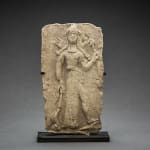Old Babylonian Moulded Plaque, 2000 BCE - 1700 BCE
Terracotta
13.1 x 6.4 cm
5 1/8 x 2 1/2 in
5 1/8 x 2 1/2 in
LO.1219
The Old Babylonian period describes south Mesopotamia in the period about 2000-1600 BC. The early years saw a number of important states dominating the region: Isin, Larsa, Eshnunna and, from...
The Old Babylonian period describes south Mesopotamia in the period about 2000-1600 BC. The early years saw a number of important states dominating the region: Isin, Larsa, Eshnunna and, from 1894 BC, Babylon. Babylon was ruled by a dynasty of Amorite kings. The sixth ruler was Hammurapi, who defeated the other southern states and expanded his control into north Mesopotamia. On the death of Hammurapi the empire gradually shrank over about 150 years. Nonetheless, Babylon remained an important power until it was sacked by the Hittite king, Mursili I, in about 1595 BC. During the Old Babylonian period literary activity flourished with scribes composing and recording religious, poetic and 'scientific' works in Sumerian and Akkadian cuneiform. Perhaps the most famous
he female figure on the plaque is the goddess Inanna, here depicted crowned, wearing a long tufted garment covering her lower body, with an arrow in her left hand and with weapons emerging from her shoulders, suggesting that she is indeed Ishtar, the Semitic form of Inanna, the goddess of fertility and of war, in her warlike attire. As a goddess of war, she wears full battle armor, armed with bow and arrows, or with other weapons at hand. As in many images of Ishtar, her lower body is depicted in profile and her upper body is shown frontally, with her head en face and fully engaging the viewer’s attention. This depiction was already popular during the Akkadian period, as suggested by a mould fragment datable to the reign of Naram-Sin (2220-2184 BC) in the Metropolitan Museum of Art in New York, and kept on being favoured during the Old Babylonian period.
Reference: for a comparable depiction of Ishtar on the Naram-Sin mould see J. Aruz, ed., Art of the First Cities, NY, 2003: p.206, no.133. Also D.P. Hansen, “ Through the love of Ishtar”, in Of Pots and Pans,: Papers on the Archaeology and History of Mesopotamia and Syria Presented to David Oates in Honour of His 75th Birthday, Ed. By Lamia al-Gailani Werr et al., pp. 91-112, London.
he female figure on the plaque is the goddess Inanna, here depicted crowned, wearing a long tufted garment covering her lower body, with an arrow in her left hand and with weapons emerging from her shoulders, suggesting that she is indeed Ishtar, the Semitic form of Inanna, the goddess of fertility and of war, in her warlike attire. As a goddess of war, she wears full battle armor, armed with bow and arrows, or with other weapons at hand. As in many images of Ishtar, her lower body is depicted in profile and her upper body is shown frontally, with her head en face and fully engaging the viewer’s attention. This depiction was already popular during the Akkadian period, as suggested by a mould fragment datable to the reign of Naram-Sin (2220-2184 BC) in the Metropolitan Museum of Art in New York, and kept on being favoured during the Old Babylonian period.
Reference: for a comparable depiction of Ishtar on the Naram-Sin mould see J. Aruz, ed., Art of the First Cities, NY, 2003: p.206, no.133. Also D.P. Hansen, “ Through the love of Ishtar”, in Of Pots and Pans,: Papers on the Archaeology and History of Mesopotamia and Syria Presented to David Oates in Honour of His 75th Birthday, Ed. By Lamia al-Gailani Werr et al., pp. 91-112, London.



